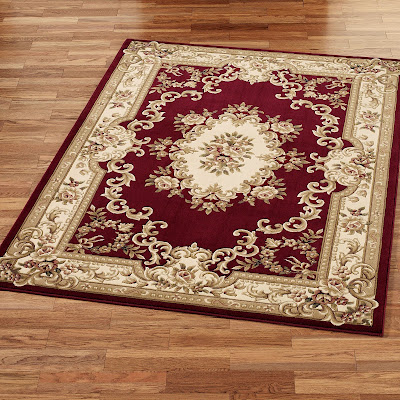The 7 most beautiful types of oriental carpets
Foreigners often use Oriental Rugs to cover the hand-woven carpets of all Eastern countries, including Pakistan, India, Nepal, Afghanistan, Iran and China, but in fact, the hand-woven carpets of every country and region, no matter from the color scheme or the pattern, All have their unique characteristics. Today we chooses the 7 most beautiful types of oriental carpets for everyone to see.
1. Aubusson Rugs
Aubusson is a flat-woven carpet originated in Felletin, a small town in central France. The patterns are all very elegant French court patterns, but now only China, India and Pakistan are produced. In addition, China produces very few aubsone, weavers are hard to find, and orders are unstable, so labor prices are rising year by year.

There are carpets and tapestries in Aubusson, usually made of wool and silk. Obssons come in large and small sizes. Antique Obssons are actually large in size, usually more than 17 square meters, which is very luxurious.
The Aubusson carpet surface is relatively thin, because it is a plain weaving process, so there are intricate carpet yarns on the back of the carpet. In order not to affect the appearance, some will cover up the back of Aubusson. In addition to the general French flower patterns, the patterns of the Aubusson carpets also include figures and landscapes.
Friendly reminder, if you want Obsson, you must first understand this product. Often customers see the patterns of Obsson and find it beautiful, but after they are made, they are very disappointed to see the actual product. There is still a big difference between Aubusson and ordinary carpets, and Sister Zhinv will write an article about Aubusson in the future
2. Bokhara Rugs
The Bukhara carpet is a hand-knotted carpet, originated in Uzbekistan, a Central Asian country. Because this style prevailed for a while, the city Bukhara was named after the carpet. In addition, this kind of carpet can be seen in Pakistan, Turkey, Turkmenistan, Uzbekistan and Afghanistan. Bukhara carpets are very popular among Westerners because of their soft surface.
The pattern of the Handmade Bukhara rugs are very characteristic, formed by repeated geometric patterns such as oval or rhombus. The colors of the carpet are all very saturated colors, such as ruby, but also green, red, ivory and gray.
3. Chobi Rugs
Chobi rugs are also hand-knotted rugs. It is a style created by a carpet company in the United States and a carpet company in Pakistan. I will not mention the name. It is very popular in North America. Later, it was mass-produced in Pakistan and Afghanistan. For the North American market.
Chobi carpet is a type of carpet developed to cater to the American home furnishing fashion. It has changed the style of oriental carpets with bold colors and dense patterns, and used mild, antique earth or gold tones to match the colors, and the patterns are also simple. The floral patterns are dotted on the carpet, sparse and uniform. And the carpet has carpet edges and corners.
4. Gabbeh Rugs
Gabbeh Rugs is also a very characteristic oriental carpet. In fact, it is a kind of Persian carpet, which originated in southwestern Iran. Gabbeh has a primitive and natural meaning in Persian, and Gabbeh carpet is actually a tribal carpet. carpet is actually a tribal carpet.
The patterns of Gabbeh rugs are very interesting. They are usually geometric or pictographic patterns of animals and plants. They even look a bit cartoonish. They are sparse, orderly, and modern. The carpet surface uses less color, generally 5-7 colors are used. Gabbeh carpets are usually made of wool and are knotted by hand. It is also a common carpet style in Iranian carpet shops.
5. Kazak Rugs
Kazak carpets are mainly produced in Armenia and Afghanistan and are made by hand knotting. Kazak carpets usually have 3-7 colors. The common colors are deep red, cyan and ivory. The patterns on the carpet surface include animals, flowers and central sunflowers, much like tribal carpets, but the patterns of Kazak rugs are usually expressed in straight lines.
6. Oushak Rugs
The origin of Oushak carpet is a small town called Oushak, located in the south of Istanbul, the capital of Turkey. Although Oushak originated in Turkey, it is different from other Turkish rugs. Oushak rugs have distinctive Persian rug characteristics, such as geometric patterns and the layout of central sunflowers, and the layout of small central sunflowers spread all over the carpet and dotted with scattered flowers.
In addition, the design of Oushak carpets and the patterns on the surface of the carpet are somewhat larger. The color ratio of carpets is mild. Yellow-brown, terracotta, gray, etc. are all commonly used colors, and the material is usually wool.
7. Overdyed Rugs
Overdyed rugs are originated in Istanbul, Turkey. Overdyed means excessive dyeing. It was originally a method used to treat faded old carpets to make the old carpets look brighter. Normally, no matter what color the original carpet is, when re-dying, only one color will be selected and the original carpet color will be covered, only showing the color to be dyed.
Later, it gradually evolved into a carpet style. No matter how the pattern changes, the carpet surface has only one main color, and the surface of the carpet shows deep or shallow changes, giving people a sense of collision between a modern abstract style and traditional patterns.


Comments
Post a Comment